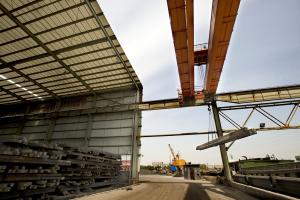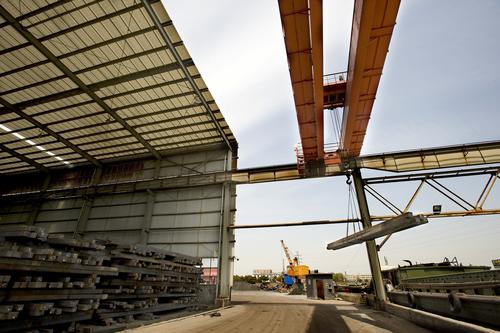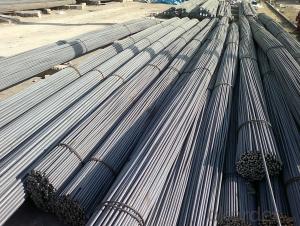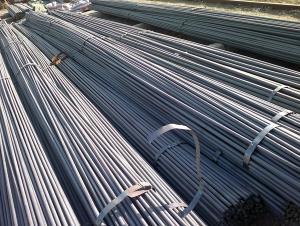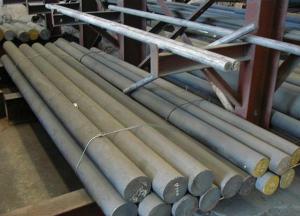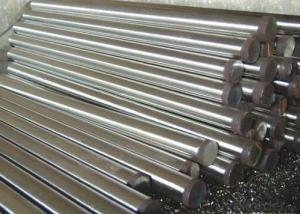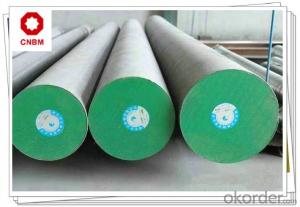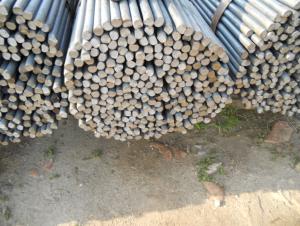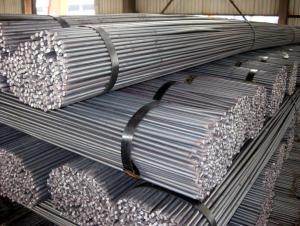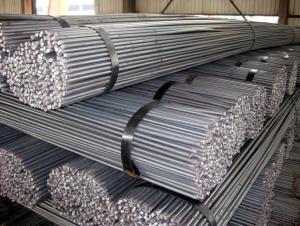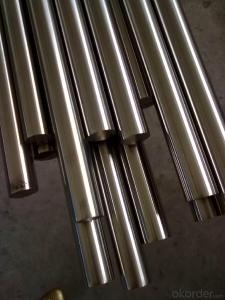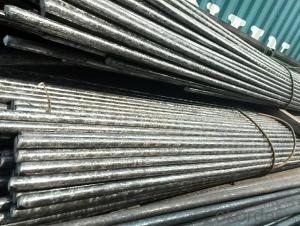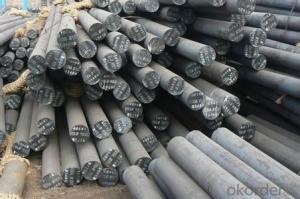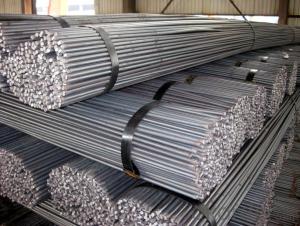steel carbon round bar
- Loading Port:
- China Main Port
- Payment Terms:
- TT or LC
- Min Order Qty:
- -
- Supply Capability:
- -
OKorder Service Pledge
OKorder Financial Service
You Might Also Like
Product Description:
OKorder is offering Round Bar at great prices with worldwide shipping. Our supplier is a world-class manufacturer of steel, with our products utilized the world over. OKorder annually supplies products to European, North American and Asian markets. We provide quotations within 24 hours of receiving an inquiry and guarantee competitive prices.
Product Applications:
1. Hot rolled round bar of 6-25mm, or small round is mostly used for straight bundles supply, and used for steel, bolts and various mechanical parts. While the bigger round bar, or more than 25mm hot rolled bar, is mainly for the manufacture of mechanical parts or for seamless steel billet.
2. Besides, we can supply some especial material steel round bar that can be used for main shaft of steamer, hummer shank, with big section and supper force.
Product Advantages:
OKorder's Round Bar are durable, strong, and resist corrosion.
Main Product Features:
· Premium quality
· Prompt delivery & seaworthy packing (30 days after receiving deposit)
· Corrosion resistance
· Can be recycled and reused
· Mill test certification
· Professional Service
· Competitive pricing
Product Specifications:
1. Grade: Q195, Q235, Q345
2. Diameter: 6mm-150mm
3. Length: 6m, 9m, 12m or as customer’s request
4. Tolerance: Within ±5% for weight; ±2mm for diameter
5. Note: The price can be better is the quantity is good
6. Chemical composition
Alloy No | Element (%) | ||||
C | Mn | S | P | Si | |
Q195 | 0.06-0.12 | 0.25 | ≤0.05 | ≤0.045 | ≤0.3 |
Q235 | 0.12—0.20 | 0.3—0.7 | ≤0.045 | ≤0.045 | ≤0.3 |
Q345 | ≤0.2 | 1.00-1.60 | ≤0.045 | ≤0.045 | ≤0.55 |
Packaging & Delivery of Round Bar
Packaging Detail: All goods are packed in bundle with steel strips and shipped by break bulk vessel or container (depend on target market and different ports)
Delivery Detail: 45 days
Trade terms: FOB, CFR, CIF
Quality Assurance of Round Bar
1. We will strictly inspect our production that we sold according to the customer’s request.
2. Quality should be in conformity with the specification of the manufacturer. Quantity and packing conditions should be in conformity with the term in the contract.
3. Should the packing found damaged, the buyer has the right to claim to the seller.
FAQ:
Q1: Why buy Materials & Equipment from OKorder.com?
A1: All products offered byOKorder.com are carefully selected from China's most reliable manufacturing enterprises. Through its ISO certifications, OKorder.com adheres to the highest standards and a commitment to supply chain safety and customer satisfaction.
Q2: How do we guarantee the quality of our products?
A2: We have established an advanced quality management system which conducts strict quality tests at every step, from raw materials to the final product. At the same time, we provide extensive follow-up service assurances as required.
Q3: How soon can we receive the product after purchase?
A3: Within three days of placing an order, we will begin production. The specific shipping date is dependent upon international and government factors, but is typically 7 to 10 workdays.
Q4: What makes stainless steel stainless?
A4: Stainless steel must contain at least 10.5 % chromium. It is this element that reacts with the oxygen in the air to form a complex chrome-oxide surface layer that is invisible but strong enough to prevent further oxygen from "staining" (rusting) the surface. Higher levels of chromium and the addition of other alloying elements such as nickel and molybdenum enhance this surface layer and improve the corrosion resistance of the stainless material.
Images:
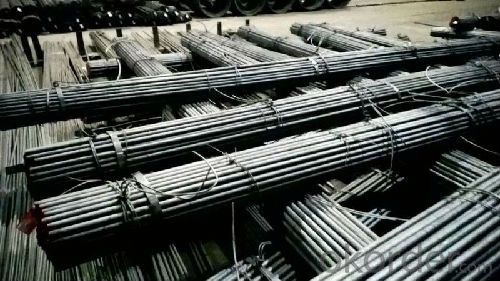
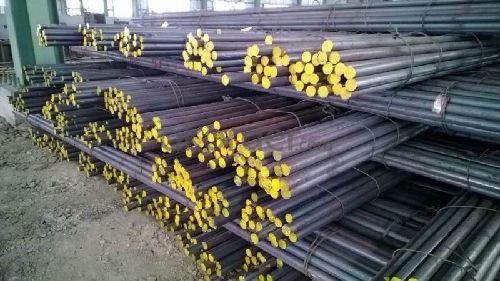
- Q: What is the difference between a centerless ground and a rough turned steel round bar?
- A centerless ground steel round bar and a rough turned steel round bar differ in terms of their manufacturing processes and resulting surface finishes. A centerless ground steel round bar is produced by feeding the bar through a grinding machine that removes material from the surface to achieve precise diameter and roundness tolerances. This process involves rotating the bar between two grinding wheels while applying pressure to remove any imperfections and create a smooth, polished surface finish. The end result is a highly accurate and consistent diameter with a mirror-like finish, making it suitable for applications that require tight tolerances and a polished appearance. On the other hand, a rough turned steel round bar is manufactured through a different machining process called turning. This involves rotating the bar against a cutting tool that removes material from the surface in order to achieve the desired diameter and shape. However, unlike centerless grinding, turning does not provide the same level of precision and surface finish. The resulting surface of a rough turned bar will have visible tool marks and a rougher texture compared to a centerless ground bar. In summary, the main difference between a centerless ground steel round bar and a rough turned steel round bar lies in their manufacturing processes and resulting surface finishes. Centerless grinding offers a more precise diameter, roundness, and smoother surface finish, making it ideal for applications that require tight tolerances and a polished appearance. Rough turning, while less precise and with a rougher surface finish, is still suitable for applications that do not require the same level of precision or aesthetic appeal.
- Q: What are the different types of steel round bars used in the automotive suspension systems?
- Automotive suspension systems utilize various types of steel round bars, each with its own distinct properties and benefits. 1. Carbon steel round bars, which are the most commonly employed in automotive suspension systems, offer excellent strength and durability. Their ability to withstand the weight and stress of vehicles make them an ideal choice. Additionally, carbon steel round bars boast exceptional machinability, allowing for easy customization and fabrication. 2. Alloy steel round bars are created by incorporating different alloying elements, such as chromium, nickel, or molybdenum, into carbon steel. This enhances their mechanical properties, resulting in increased strength, hardness, and wear resistance. These alloy steel round bars are frequently utilized in crucial suspension components like control arms or sway bars. 3. Stainless steel round bars are renowned for their resistance to corrosion and aesthetic appeal. Although not as prevalent in automotive suspension systems, they find application in specific scenarios where protection against rust or chemical exposure is necessary. Furthermore, stainless steel round bars offer considerable strength and high temperature resistance, making them suitable for specific suspension components. 4. High-strength steel round bars are explicitly designed to provide exceptional strength and toughness. These bars are commonly employed in demanding suspension applications, including heavy-duty trucks or performance vehicles, which require increased load-bearing capacity and enhanced resistance to fatigue. 5. Forged steel round bars are distinguished by their exceptional strength and structural integrity. They are formed by subjecting the steel to high temperatures and shaping it under immense pressure. This manufacturing process results in a dense and uniform structure, rendering forged steel round bars highly reliable and suitable for rigorous suspension systems. In conclusion, automotive suspension systems utilize several types of steel round bars, including carbon steel, alloy steel, stainless steel, high-strength steel, and forged steel. Each type possesses unique properties and advantages tailored to the specific requirements of various suspension components.
- Q: Can steel round bars be used for structural purposes?
- Indeed, steel round bars have the capability to serve structural purposes. Due to their robustness and endurance, round bars are frequently employed in construction and engineering ventures. These bars function as weight-bearing elements in edifices, bridges, and other structures, offering essential support and stability. The availability of steel round bars in diverse grades and dimensions permits adaptability in both design and utilization. Moreover, they can be effortlessly welded, molded, and machined to fulfill precise project necessities, rendering them a favored option for structural applications.
- Q: What are the different treatments available for steel round bars?
- There are several different treatments available for steel round bars, including heat treatment, surface treatment, and coating. Heat treatment involves processes such as annealing, quenching, and tempering to improve the material's strength, hardness, and ductility. Surface treatments, such as polishing, grinding, or shot blasting, are used to enhance the surface finish and remove any imperfections. Coatings, such as galvanizing or painting, provide protection against corrosion and improve the overall appearance of the steel round bars.
- Q: Are steel round bars suitable for marine environments?
- Yes, steel round bars can be suitable for marine environments, especially if they are made from corrosion-resistant alloys such as stainless steel. These alloys have high resistance to corrosion, making them suitable for prolonged exposure to saltwater and other harsh marine conditions. However, regular carbon steel round bars may be prone to rusting in marine environments and may require additional protective measures such as coatings or regular maintenance to prevent corrosion.
- Q: Can steel round bars be used for fastener applications?
- Indeed, fastener applications can make use of steel round bars. In various industries, these round bars are frequently employed as fasteners due to their remarkable durability and high strength. By threading, drilling, or machining them, a variety of fasteners, including bolts, screws, and studs, can be fashioned. The outstanding tensile strength and corrosion resistance of steel round bars render them suitable for demanding tasks that necessitate robust and dependable fastening. Moreover, these round bars are easily obtainable in assorted sizes and grades, enabling customization based on precise fastener needs.
- Q: What is the tolerance for diameter and length of steel round bars?
- The tolerance for diameter and length of steel round bars can vary depending on the specific industry standards and requirements. Generally, the acceptable tolerance for diameter can range from +/- 0.005 to 0.010 inches, while for length it can range from +/- 0.125 to 0.250 inches. However, these tolerances can be more stringent or relaxed depending on the intended application and customer specifications.
- Q: How are steel round bars tested for quality and strength?
- To ensure that steel round bars meet the necessary standards and specifications, various methods are employed to test their quality and strength. One commonly used test is the tensile test, which measures the bar's ability to withstand tension. In this test, a sample of the steel bar is gradually loaded until it reaches its breaking point, and the maximum load it can handle is recorded, along with the sample's elongation and reduction in area. These values offer valuable insights into the bar's strength and ductility. Another test employed is the hardness test, which assesses the steel bar's resistance to indentation or penetration. This test utilizes a hardness testing machine that applies a specific force to a small indenter, such as a diamond or a steel ball, and measures the resulting indentation's depth or size. The obtained hardness values can indicate the bar's strength and its ability to withstand wear and deformation. Apart from these mechanical tests, non-destructive testing methods are also used for steel round bars. Ultrasonic testing is a common technique employed to identify internal defects or inconsistencies in the bar's structure. This method involves transmitting high-frequency sound waves through the bar and analyzing the reflected waves to detect any irregularities. Magnetic particle inspection is another non-destructive test that relies on magnetic fields and particles to identify surface or near-surface defects in the steel bar. Chemical analysis plays a crucial role in determining the quality of steel round bars. This analysis involves testing the steel's composition to ensure it meets the required chemical specifications. It helps identify the presence of impurities or elements that could impact the bar's performance and durability. In summary, steel round bars undergo a combination of mechanical, non-destructive, and chemical tests to evaluate their quality and strength. These tests provide manufacturers with essential information, enabling them to ensure that the bars meet the necessary standards and are suitable for their intended applications.
- Q: Can steel round bars be used in the production of tools?
- Yes, steel round bars can be used in the production of tools. Steel round bars are commonly used in tool manufacturing due to their high strength, durability, and versatility. They can be shaped, machined, and heat-treated to create various types of tools such as drills, punches, chisels, and hammers. The use of steel round bars ensures that the tools have the necessary hardness and toughness required for their specific applications.
- Q: Can steel round bars be used for tooling applications?
- Tooling applications can indeed utilize steel round bars. Steel, being a highly versatile material, possesses exceptional strength, durability, and resistance to wear and tear. By machining, heat treating, and shaping round bars made of steel, one can create a wide range of tools, including punches, dies, drills, and lathe tools. The round shape of these bars facilitates effortless machining and shaping processes. Moreover, the performance of steel round bars in specific tooling applications can be further enhanced through surface treatments or coatings. All in all, due to their outstanding mechanical properties and adaptability, steel round bars find widespread application in tooling.
Send your message to us
steel carbon round bar
- Loading Port:
- China Main Port
- Payment Terms:
- TT or LC
- Min Order Qty:
- -
- Supply Capability:
- -
OKorder Service Pledge
OKorder Financial Service
Similar products
Hot products
Hot Searches
Related keywords
